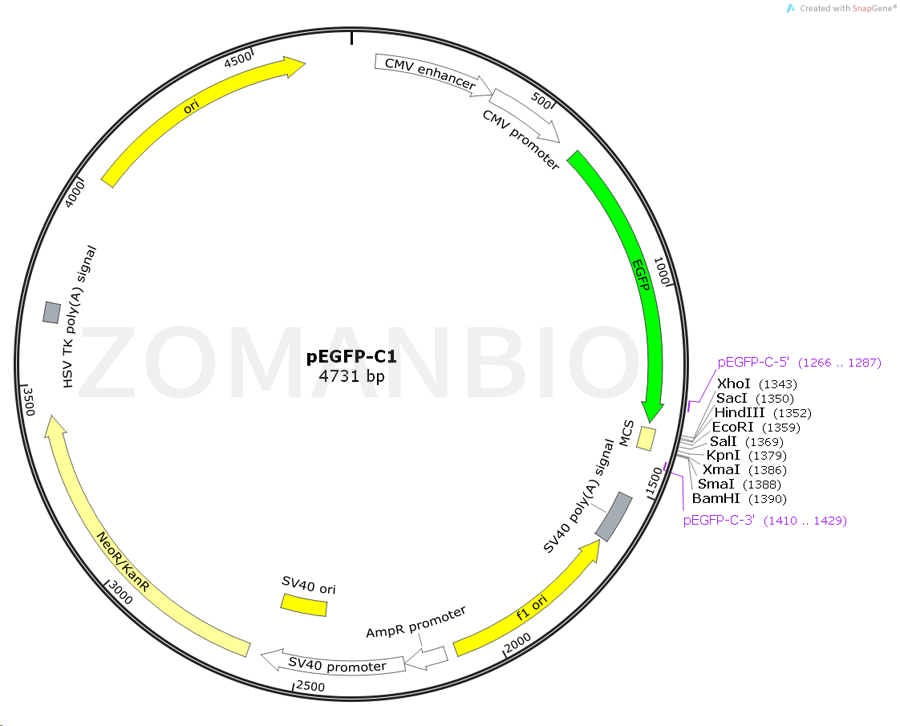■ 基本信息
别名: | pEGFPC1 |
启动子: | CMV |
复制子: | pUC |
终止子: | SV40 poly(A) signal |
质粒分类: | 哺乳系列质粒;哺乳荧光质粒;哺乳绿色质粒 |
质粒大小: | 4731bp |
质粒标签: | C-EGFP |
原核抗性: | Kan |
真核抗性: | G418 |
克隆菌株: | DH5a |
培养条件: | 37℃,5%CO2 |
表达宿主: | 293T等哺乳细胞 |
诱导方式: | 无须诱导,瞬时表达 |
5'测序引物:
| pEGFP-C-5
|
3'测序引物: | pEGFP-C-3 |
■ 质粒属性
质粒宿主: | 哺乳细胞 |
质粒用途: | 蛋白表达 |
片段类型: | ORF
|
片段物种: | 空载体
|
原核抗性: | Kan |
真核抗性: | G418 |
荧光标记: |
|
■ 质粒简介
pEGFP-C1编码野生型GFP的红移型变体,其已经针对更明亮的荧光和哺乳动物细胞中更高的表达进行了优化。(激发最大= 488nm;发射最大值= 507nm)pEGFP-C1编码GFPmut1变体,其含有Phe-64对Leu和Ser-65至Thr的双氨基酸取代pEGFPC1中的MCS在EGFP编码序列和SV40 polyA之间克隆到MCS中的基因如果与EGFP的阅读框处于相同的阅读框并且不存在中间终止密码子,则将其表达为EGFP的C末端的融合物。 EGFP基因下游的SV40聚腺苷酸信号直接适当处理EGFP mRNA的3'末端。载体骨架还含有用于在表达SV40 T抗原的哺乳动物细胞中复制的SV40来源。由SV40早期启动子,Tn5的新霉素/卡那霉素抗性基因和来自单纯疱疹病毒胸苷激酶(HSV TK)基因的多聚腺苷酸化信号组成的新霉素抗性盒(Neor)允许使用G418选择稳定转染的真核细胞。该盒上游的细菌启动子在大肠杆菌中表达卡那霉素抗性。 pEGFP-C1backbone还提供了用于在大肠杆菌中繁殖的pUC复制起点和用于单链DNA生产的f1来源。 质粒只保证关键序列正确,不保证表达效果。
pEGFP-C1encodes a red-shifted variant of wild-type GFP (1–3) which has been optimized for brighter fluorescence and higher expression in mammalian cells. (Excitation maximum = 488 nm;emission maximum = 507 nm.) pEGFP-C1 encodes the GFPmut1 variant (4) which contains the double-amino-acid substitution of Phe-64 to Leu and Ser-65 to Thr. The coding sequence of the EGFP gene contains more than 190 silent base changes which correspond to human codon-usage preferences (5). Sequences flanking EGFP have been converted to a Kozak consensus translation initiation site (6) to further increase the translation efficiency in eukaryotic cells. The MCS in pEGFPC1is between the EGFP coding sequences and the SV40 poly A. Genes cloned into the MCS will be expressed as fusions to the C-terminus of EGFP if they are in the same reading frame as EGFP and there are no intervening stop codons. SV40 polyadenylation signals downstream of the EGFP gene direct proper processing of the 3' end of the EGFP mRNA. The vector backbone also contains an SV40 origin for replication in mammalian cells expressing the SV40 T-antigen. A neomycin resistance cassette (Neor), consisting of the SV40 early promoter, the neomycin/kanamycin resistance gene of Tn5, and polyadenylation signals from the Herpes simplex virus thymidine kinase(HSV TK) gene, allows stably transfected eukaryotic cells to be selected using G418. A bacterial promoter upstream of this cassette expresses kanamycin resistance in E.coli. The pEGFP-C1backbone also provides a pUC origin of replication for propagation in E. coli and an f1 origin for single stranded DNA production.
Fusions to the C terminus of EGFP retain the fluorescent properties of the native protein allowing the localization of the fusion protein in vivo. The target gene should be cloned into pEGFP-C1 so that it is in frame with the EGFP coding sequences, with no intervening in-frame stop codons. The recombinant EGFP vector can be transfected into mammalian cells using any standard transfection method. If required, stable transformants can be selected using G418 . pEGFP-C1 can also be used simply to express EGFP in a cell line of interest (e.g., as a transfection marker).
Propagation in E. coli
• Suitable host strains: DH5α, HB101, and other general purpose strains. Single-stranded DNA production requires a host containing an F plasmid such as JM109 or XL1-Blue.
• Selectable marker: plasmid confers resistance to kanamycin (30 µg/ml) to E. coli hosts.
• E. coli replication origin: pUC
• Copy number: ≈500
• Plasmid incompatibility group: pMB1/ColE1
■ 质粒图谱

■ 质粒序列
质粒序列请下载: ZK414pEGFP-C1哺乳荧光质粒.txt
ZK414pEGFP-C1哺乳荧光质粒.txt



